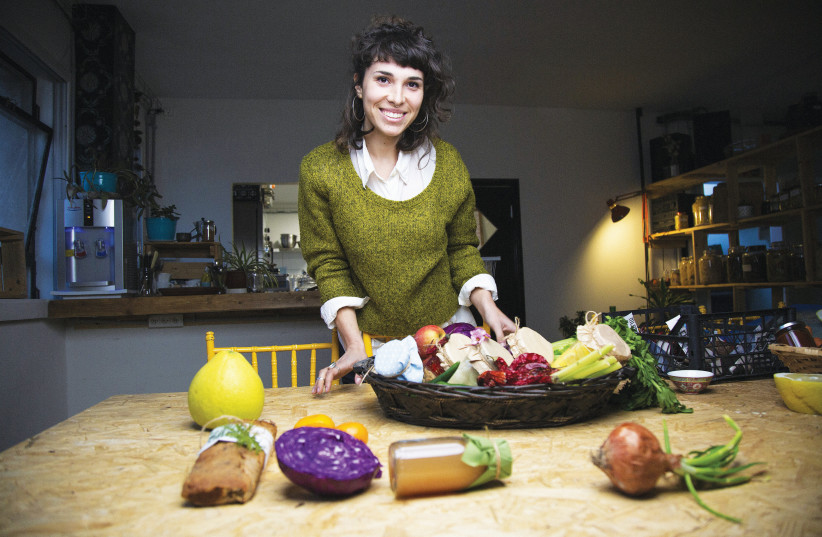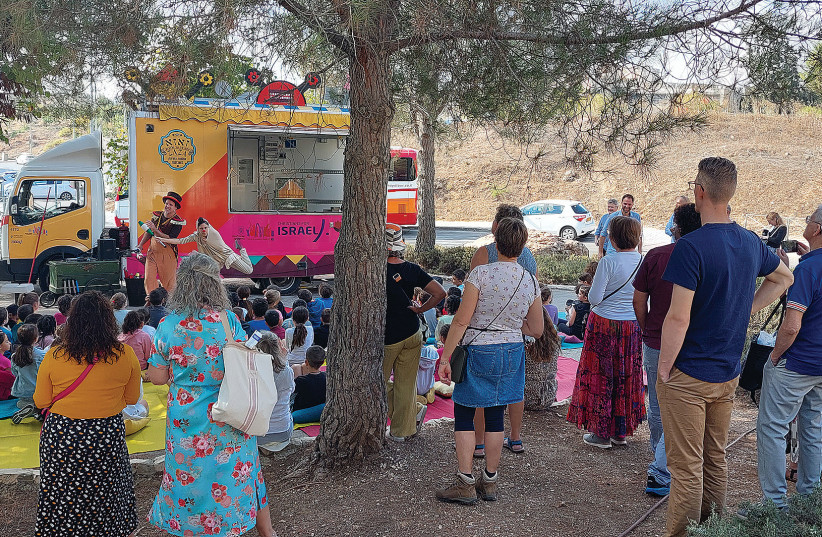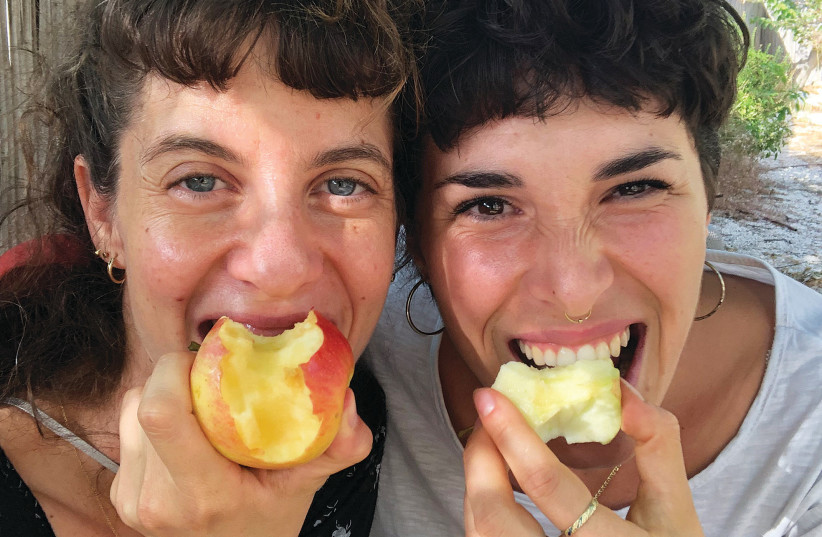The apple has its own niche in the history of humankind. The biblical context places the fruit at the epicenter of a game-changing moment when, according to Scripture, the wily serpent tempted Eve to sink her molars into the forbidden fruit plucked from the Tree of Knowledge.
Ruth Hof has a different, contemporary, take on the apple as will become apparent to anyone who makes their way over to any of the four sites around Jerusalem where the Autozaza truck is due to be located on October 10-12 and 16.
The municipality-owned vehicle has been pressed into good service several times over the years for the benefit of Jerusalemites of all ages. Entertainment, games, and interactive activities have been laid on, gratis, at the various compounds tailored to suit the theme du jour.
This year, the accent is on matters ecological and natural, and getting us to consider what goes into our mouths, what we shell out our hard-earned cash on, and whence and how the comestibles find their way to us. The apple has a starring role in the narrative.
Hof has built up an impressive body of work over the last decade in stage productions and performance art across a broad sweep of topics and styles. And she is putting her artistic experience, gleaned in all sorts of creative areas, to good use for all and sundry.

Jerusalemite multidisciplinary artist and collaborators producer Yael Chifman and Daniella Seltzer from the Food Rescuers gang over at the fruit and veg wholesale market in Givat Shaul will set up their stall – literally and thematically – in the Katamonim (Park Gonenim); Pisgat Ze’ev (Pascal Square); Kiryat Yovel (Mifletzet Pub); and Ein Kerem (The Spring Plaza). The fun, enlightening, entertaining, and inspirational stuff, initiated by Food Rescuers, will run from 7-10 p.m. on each of the appointed days, supported by the Jerusalem Municipality and the Jerusalem Foundation.
Hof has pulled out all the creative stops to ensure that we absorb the wholesome ecological message. For starters, the truck will be decked out in fruit and vegetable-oriented finery, with all the edibles coming from Seltzer and her team’s ongoing efforts to rescue perfectly usable food items from the trash heap.
Food Rescuers, which now has a healthy harmonious relationship with the hardy folks who run the market, save tons of serviceable food from being dumped each year, thereby reducing the strain on an already overtaxed global environment. Since it started out, Food Rescuers has saved an astronomical 550 tons of perfectly usable fruit and veg.
13% of food falls by wayside between harvest stage and availability in retail
A recent United Nations report indicates that 13% of food falls by the wayside between the harvest stage and its availability in retail outlets. That figure is further exacerbated by the fact that an estimated additional 17% of total global food production is wasted in the home and in the food industries.
The organizers of last week’s UN-sponsored International Day of Awareness of Food Loss and Waste said the event was “an opportunity to call to action both the public (national or local authorities) and the private sector (businesses and individuals) to prioritize actions and move ahead with innovation to reduce food loss and waste, toward restoring and building better and resilient-ready food systems.”
Hof goes along with that notion, proffering some of her own stats. “In 2022, some 1.3 million tons of food products were dumped, half of which was suitable for human consumption,” she states. “And there are a million families who live without food security. That is absurd.” That’s putting it mildly. “Inhumane” and “criminal” might be more accurate epithets to use here.

Hence the Autozaza and Food Rescuers ventures, which aim to save food – and by direct extension, valuable resources – from being wasted and hopefully help stem the erosion of our living space and quality of life here on planet Earth.
HOF’S PLAN of action on the four dates is designed to induce a reflective approach to how our food gets to our plates and bowls, what we eat, and how we treat the vittles which, for many, appear to be very much a matter of easy come, easy go.
How many of us really consider what we eat, how we eat, and how much we really need to eat? We all get peckish and dig into snacks – mostly not of the nutritious kind – that we don’t actually need to keep our bodies operating at optimum levels.
Visitors to the aforementioned locations over the next week or so will be drawn into the thick of the revelatory action right from the off.
“People who come to the compounds will encounter something like Tourist Information,” Hof explains. “They will wait there and get a brief about the event.”
Information and an opportunity to get involved in the goings-on provide the starter to the Autozaza experience.
“Everyone will get what I call a ‘pocket question’ – it is also the size of a pocket. On one side it will say ‘When did you last save something or someone?’ And, on the other side, it will say ‘Have you ever been saved?’” The searching queries will sit and gestate while we make our way through the various stops around the site. “People don’t have to respond to the questions, but they will have lots of opportunity to do that during the course of the evening, in writing or verbally, if they so desire,” Hof adds.

“There will be plenty of inspiration on offer, eliciting our tales of rescue. There will be ‘salvagers’ sitting at a table telling rescue stories,” says Hof. In fact, visitors will be enveloped in a microcosm of ecological intent, green pursuits, and other endeavor that aims to keep Mother Nature in as good shape as possible.
Hof says that Autozaza follows a laissez-faire mindset. “People can move freely among the various stations, either according to the stations that are available or however they wish.” Sustenance will be provided to make sure people have the energy to keep up with the compound circuit. “They will be given a portion of rescued food, together with an operating manual.”
Sounds intriguing and just a little puzzling. Surely, we all learn how to eat on our own at an early age. Why does Hof feel we need a helping hand as we chomp away? She says it is all about drawing us into the ecological, spiritual, and definitively existential subtext behind what, thankfully, is a matter of mundane course for the vast majority.
Take, for example, the Water Bar stop in the Autozaza set-up. Water is water, right? Not as far as Hof is concerned. She is laying on several nuanced takes on the fundamental life-giving liquid for our imbibing pleasure and contemplation. “There will be all sorts of ‘suggests’ [with regard to the flavoring of the water]. I call it swallowing information – all sorts of things we may not know about water, emotionally, politically. By ‘political’ I mean climate politics,” Hof hastens to add, noting that she generally tries her best to give political machinations a wide berth. “We have enough of politics in the general run of things.”
The term “bar” generally conjures up images of subtle lighting, probably piped music, and certainly a wide array of beverages to choose from. The Autozaza drinking hole sticks to Adam’s ale but spices up the aqua with various vegetable undertones. Hof is looking to provide us with an ingesting experience that takes us beyond the basic thirst-quenching dynamics and into the realms of the back story of Mother Nature’s offerings, and how we should appreciate the ease of access to water that we enjoy and take for granted.
“There will be 13 cups of water with different flavors,” she says. Naturally, that is not just about how the liquid permutations titillate our tongue sensors.
“Each cup is, in fact, a different suggestion about how to sense, encounter, feel, and drink water. There is, for example, a portion called Still Water Runs Deep,” she elaborates. That is a catchy and suggestive moniker for a unique multi-sensory slot. “You cover your ears, and the barman tips the water into your mouth. It is powerful. There is the emotional dimension. You get the sense of water running deep. That helps to develop your imagination and your thoughts [about water]. And you can think about how much water we have in our own body.”
Hof spreads her creative gifts across eclectic topics and fields as she seeks to convey messages and stimulate our reimagining processes and our emotions. She draws on that powerful diverse arsenal for this venture as well.
“There is also a cup of water called ‘Cup of Longing,’ whereby you can go back to a water drinking experience you once had. I call it making proposals to people through play, movement, maybe a sound file – almost always with an emotional and reflective content.”
Hof credits Seltzer with bringing her more deeply into the ecological side of things for the Autozaza project and in general. “That came from Daniella. She does so much good and important work. I learn so much from her.”
There was more help on offer. “This project is the result of a shidduch with Hila Smoliansky from the Department of Visual Arts in the municipality. She paired me with Daniella, who added the ecological aspect.
“We realized that we want to provide people with knowledge, but that is not enough. We want people to feel, sense things palpably. To understand the connection between our actions and feelings. Then maybe the change will start – getting people to think and relate differently to the food we eat. Maybe they will think twice before they chuck something out.”
Hof comes up with a startling statistic. “Even food which is not organic involves massive investment in time, air, water, land, thought. Food waste accounts for 10% of greenhouse gas emissions.”
WE EVENTUALLY get back to – pardon the pun – the core fruit. “There is a ‘sound work,’ where you are given an apple, a torch, and a map,” says Hof. “While you eat the apple, you hear the story of the whole journey it underwent to get to you.”
The map helps impart the meandering route from grower to consumer, and you can use the torch to inspect the minutiae of the apple’s skin and the innards as you bite into it. “That’s something we don’t normally do,” Hof observes.
Hof got a close handle on the apple trail. “I spoke to the marketer, and I had a long talk with the farmer on Kibbutz Baram [on the Lebanese border]. He told me a lot about the business of getting produce to markets and retail outlets that I didn’t know.” She also spoke to the man directly responsible for relocation and delivery. “I talked to the Bedouin driver and asked him what he thinks about during the journey. He said he thinks about his four children and how to give them the chance of a better life. All those energies go into what we eat,” she says.
It is clearly not just about planting and cultivating – in this case – a fruit tree, and picking and selling the yield. Hof wants us to consider the human aspects, not just the base ecological factors.
“This whole process is connected to people, from A to Z. We have a Soul Searching station in the Autozaza enclosure. We write down all the people who contributed to getting the fruit there. Participants can [include] themselves. We need to see ourselves as part of the whole. We can only do our best.”
There will also be enlightening contributions by Nir Amit from the Secular Yeshiva in Jerusalem, a performative talk about the food chain, and a musical slot. Not a bad recipe for leaving us with wholesome food for thought. ❖
